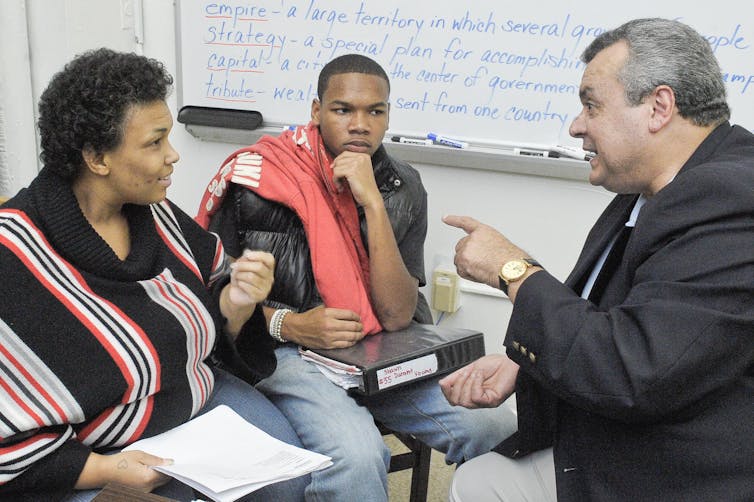
Five new ways for schools to work with families
Text messages, email alerts, open houses, fundraising appeals, robocalls – parents know the drill. They are inundated with requests from children’s schools.
These missives aren’t really asking for engagement. Rather they can be viewed as ways for educators to tell parents what they should do to support their students or the school. These experiences can inadvertently communicate that schools alone know what’s best for children – and parents should listen and follow directions, a dynamic especially present in schools serving working-class communities of colour.
As scholars and parents, my colleagues and I research the intersection of families, schools and racial inequities. We have learned new ways for schools and families to work together to help realise children’s potential. And the answer isn’t fundraising, checking the latest school app or listening to robo-calls.
By Ann M. Ishimaru, University of Washington; Megan Bang, Northwestern University, and Michelle Valladares, University of Colorado Boulder
Research tells us that families play a critically important role in the educational success of their children. We also know from research that schools typically expect parents and families of colour to conform to the values and behaviors of white, middle-class parents.
‘..age-old narratives that implicitly blame families of colour’
The hitch is that families of colour don’t always participate in the ways schools expect. Histories of distrust and conflict often exist between families of colour and schools.
We know, for example, that there are well-documented racial disparities in discipline referrals, in access to high-quality teachers and instruction, and in resources and robust learning opportunities. But when parents raise questions about racial bias and inequities, their questioning, our research and other work has shown, it is rarely well received by educators and school leaders.
Rather than acknowledging these well-documented tensions and revising expectations, educators can interpret behaviours that deviate from their expectations as evidence that there’s something wrong or lacking in families of colour. A study by Dr. John Diamond and his colleagues found that when teachers decide parents don’t care or are interfering with their professional authority, they tend to feel less responsible for those students’ learning. These assumptions rely on age-old narratives that implicitly blame families of colour – and have negative consequences, especially for Native American, black, Latinx, Pacific Islander and some Asian students.
 A parent-teacher conference.
A parent-teacher conference.
flickr.com, CC BY-NC
Catalyzed by a charge from the 2014 White House Symposium on Transformative Family Engagement, we have been working on a different set of approaches to co-design more “just schools” with families. Based on the research of our national network of scholars and family leaders, Family Leadership Design Collaborative, schools and policymakers can approach families differently. They can:
1. Start with families’ and communities’ priorities, not the school’s agenda
Families and communities need to be the architects of their own futures. That means starting with family stories, experiences, knowledge and cultural practices. That might mean recognising negative histories with schools before jumping to solutions. For example, in Chicago’s urban Indigenous community, families discussed the trauma of boarding schools and the erasure of Indigenous communities. They also shared their ancestral knowledge and stories of raising children to envision what education would be required to raise “good elders.” Parents in another district shared experiences of positive relationships with teachers but also their frustrations dealing with bullying and racism at the school.
After sharing these experiences, they developed a curriculum for other parents to help them build relationships with each other to address issues of bullying and to support positive racial and cultural identities for their children.
2. Recognise and treat families of colour as experts on their own children
When schools help families build relationships with each other and recognise their expertise, they can become powerful leaders in school change. In Los Angeles, black and Latinx parent leaders with the organising group CADRE changed the discipline policies in the district. And yet, based on our research, parents of colour still felt blamed and judged in everyday conversations with teachers and principals about discipline – and there had been little change in the pipeline from school to prison, especially for black boys. Now those parent leaders are collaborating with faculty at UCLA to help new teachers reshape everyday conversations to be less about blame and more about enabling parents to share their expertise on their own children.
3. Give families and communities the resources, time and space to envision solutions, not just share their pain
Listening sessions can be powerful but limiting. Families share their traumas with educators, but school leaders ultimately decide what to do with what they heard. Our research shows how families can be part of designing solutions if they are provided the time, space and resources to do so. For example, in Salt Lake City, a school decision-making body supposedly included parents, but families of colour experienced meetings as alienating and exclusionary. We found rather than airing those negative experiences and expecting policymakers to do something, parents, teachers, principals, researchers and district leaders imagined what a productive council would be like and started to enact those changes. They got the legislature to let them use funds for outreach to more diverse families. They created a comic to share with parents whose first language wasn’t English. They are developing a training for educators on the councils to learn how to engage differently. And they envisioned spaces prior to formal council meetings for parents to come together to discuss what their schools need most.
4. Help families and educators learn to facilitate meetings across racial, cultural and other differences
According to the U.S. Department of Education, most teachers and leaders in the U.S. are white, and a growing majority of students and their families are from communities of colour. Collaborating across lines of race, culture and roles requires skilful facilitation. Real tensions emerge between people and ideas in equity work. School and parent leaders need to be able to intervene in tense interactions. That might be as simple as asking educators to slow down, listen more and use fewer acronyms. But imbalances of power often require skilled facilitation, like what to do when one loud voice dominates the conversation or when white parents inadvertently disregard parents of colour.
Even parents of colour can reinforce these narratives. For instance, one group of immigrant parents in a diversifying suburban district voiced a belief that other immigrant families are focused on meeting their immediate needs and don’t care about their children’s education. The facilitator at this session could have gone with this simplistic explanation that blamed parents for disparate opportunities – a stereotype that empirical research has proven wrong. Instead, the facilitator leaned into the tension and shared her own challenges as a working parent who was often away from her child. Her vulnerability challenged the discourse of blame, and parents began to strategize about how they could better support each other collectively. Such facilitation skills must be learned, and schools and systems need to invest in developing those capacities.
5. Ensure families have real influence on important educational decisions
School and district leaders in our study came to see the routine decisions they made in their jobs as critical opportunities for family and community influence. Educational leaders redesigned key decisions that impacted students and families, especially those marginalised by typical processes.
For instance, one principal supervisor in an urban district redesigned the hiring process for a new principal with students, families and teachers in the school. He enlisted a colleague who helped families discuss the broken trust they felt with the district due to prior decisions, then they collectively designed their own questions for principal candidates. They held separate student, family and teacher interview panels, then proposed their top choice (which was unanimous, in this case). The district hired that principal, and several families wrote letters to the school board about how the process helped repair their broken trust with the district.
These and other actions laid out in our full policy memo can recast families and communities as essential collaborators in fostering equitable schools and educational systems.
[ Deep knowledge, daily. Sign up for The Conversation’s newsletter. ]![]()
Ann M. Ishimaru, Associate Professor, University of Washington; Megan Bang, Professor of Learning Sciences and Psychology, Northwestern University, and Michelle Valladares, Associate Director of the National Education Policy Center, University of Colorado Boulder
This article is republished from The Conversation under a Creative Commons license. Read the original article.




